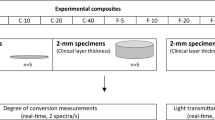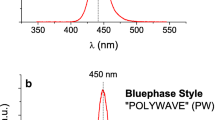Abstract
The present study aimed to introduce a novel two-step photo-activation protocol of dental resin-based composites (RBC) using optical fibers. The objective was to investigate the effect of the proposed modality on polymerization shrinkage, considered as the main disadvantage of RBCs, by measuring tooth model deformation using real-time digital holographic interferometry (DHI). Simultaneous real-time monitoring of RBC temperature rise was conducted, using infrared thermography (IRT). Degree of conversion was measured at various depths, immediately after curing and after 24 h of dark storage, using Raman spectroscopy. Standardized tooth models made of dental plaster with a class II mesial-occlusal-distal cavity were used as molds for RBC fillings. The proposed two-step curing was designed as follows: in the first step–optical fibers connected to a commercial dental LED curing unit were inserted into the dental filling to cure the RBC from within; in the second step–fibers were extracted, remaining voids were filled with the RBC, and final conventional curing was performed. The final deformation value, defined as the sum of the measured values after the first and second curing step, was significantly lower (on average 36%) compared to conventional curing, as measured by DHI. Meanwhile, no influence of the photo-activation protocol on DC was revealed. IRT was demonstrated as a simple and useful method for coupling with DHI, providing additional essential information on polymerization reaction dynamics.












Similar content being viewed by others
Data availability
The datasets generated during and/or analyzed during the current study are available from the corresponding author upon reasonable request.
Code availability
The software application supports the presented results and complies with the field standards.
References
Al-ahdal, K., Ilie, N., Silikas, N., Watts, D.C.: Polymerization kinetics and impact of post polymerization on the Degree of Conversion of bulk-fill resin-composite at clinically relevant depth. Dent. Mater. 31(10), 1207–1213 (2015). https://doi.org/10.1016/j.dental.2015.07.004
Algamaiah, H., Silikas, N., Watts, D.C.: Polymerization shrinkage and shrinkage stress development in ultra-rapid photo-polymerized bulk fill resin composites. Dent. Mater. 37(4), 559–567 (2021). https://doi.org/10.1016/j.dental.2021.02.012
Alshali, R.Z., Silikas, N., Satterthwaite, J.D.: Degree of conversion of bulk-fill compared to conventional resin-composites at two time intervals. Dent. Mater. 29(9), e213–e217 (2013). https://doi.org/10.1016/j.dental.2013.05.011
Atai, M., Motevasselian, F.: Temperature rise and degree of photopolymerization conversion of nanocomposites and conventional dental composites. Clin. Oral Invest. 13(3), 309–316 (2009). https://doi.org/10.1007/s00784-008-0236-2
Ausiello, P., Ciaramella, S., De Benedictis, A., Lanzotti, A., Tribst, J.P.M., Watts, D.C.: The use of different adhesive filling material and mass combinations to restore class II cavities under loading and shrinkage effects: a 3D-FEA. Comput. Methods Biomech. Biomed. Engin. (2020). https://doi.org/10.1080/10255842.2020.1836168
Blažić, L., Pantelić, D., Savić-Šević, S., Murić, B., Belić, I., Panić, B.: Modulated photoactivation of composite restoration: Measurement of cuspal movement using holographic interferometry. Lasers Med. Sci. 26(2), 179–186 (2011). https://doi.org/10.1007/s10103-010-0774-0
Boaro, L.C.C., Lopes, D.P., de Souza, A.S.C., Nakano, E.L., Perez, M.D.A., Pfeifer, C.S., Goncalves, F.: Clinical performance and chemical-physical properties of bulk fill composites resin–a systematic review and meta-analysis. Dent. Mater. 35(10), e249–e264 (2019). https://doi.org/10.1016/j.dental.2019.07.007
Campos, L.M.P., Parra, D.F., Vasconcelos, M.R., Vaz, M., Monteiro, J.: DH and ESPI laser interferometry applied to the restoration shrinkage assessment. Radiat. Phys. Chem. 94(1), 190–193 (2014). https://doi.org/10.1016/j.radphyschem.2013.05.051
Dewaele, M., Asmussen, E., Peutzfeldt, A., Munksgaard, E.C., Benetti, A.R., Finné, G., Leloup, G., Devaux, J.: Influence of curing protocol on selected properties of light-curing polymers: degree of conversion, volume contraction, elastic modulus, and glass transition temperature. Dent. Mater. 25(12), 1576–1584 (2009). https://doi.org/10.1016/j.dental.2009.08.001
dos Sousa, G.S., Guimarães, G.F., Marcelino, E., Rodokas, J.E.P., de Júnior, A.J.O., Cesarino, I., Leão, A.L., dos Riccardi, C.S., Arjmand, M., Simões, R.P.: Shrinkage stress and temperature variation in resin composites cured via different photoactivation methods: insights for standardisation of the photopolymerisation. Polymers 13(13), 1–14 (2021). https://doi.org/10.3390/polym13132065
Feitosa, V.P., Fugolin, A.P.P., Correr, A.B., Correr-Sobrinho, L., Consani, S., Watson, T.F., Sinhoreti, M.A.C., Sauro, S.: Effects of different photo-polymerization protocols on resin–dentine mTBS, mechanical properties and cross-link density of a nano-filled resin composite. J. Dent. 40(10), 802–809 (2012). https://doi.org/10.1016/j.jdent.2012.05.014
Ferracane, J.L., Hilton, T.J.: Polymerization stress-Is it clinically meaningful? Dent. Mater. 32(1), 1–10 (2016). https://doi.org/10.1016/j.dental.2015.06.020
Germscheid, W., de Gorre, L.G., Sullivan, B., O’Neill, C., Price, R.B., Labrie, D.: Post-curing in dental resin-based composites. Dent. Mater. 34(9), 1367–1377 (2018). https://doi.org/10.1016/j.dental.2018.06.021
Gorsche, C., Griesser, M., Gescheidt, G., Moszner, N., Liska, R.: β-allyl sulfones as addition-fragmentation chain transfer reagents: a tool for adjusting thermal and mechanical properties of dimethacrylate networks. Macromolecules 47(21), 7327–7336 (2014). https://doi.org/10.1021/ma501550b
Hori, M., Fujimoto, K., Asakura, M., Nagase, Y., Mieki, A., Kawai, T.: Measurement of exothermic heat released during polymerization of a light- curing composite resin: comparison of light irradiation modes. Dent. Mater. J. 38(4), 646–653 (2019). https://doi.org/10.4012/dmj.2018-158
Ilie, N., Fleming, G.J.P.: In vitro comparison of polymerisation kinetics and the micro-mechanical properties of low and high viscosity giomers and RBC materials. J. Dent. 43(7), 814–822 (2015). https://doi.org/10.1016/j.jdent.2015.04.009
Ilie, N., Jelen, E., Hickel, R.: Is the soft-start polymerisation concept still relevant for modern curing units? Clin. Oral Invest. 15(1), 21–29 (2011). https://doi.org/10.1007/s00784-009-0354-5
Kim, M., Kim, R.J., Ferracane, J., Lee, I.: Thermographic analysis of the effect of composite type, layering method, and curing light on the temperature rise of photo-cured composites in tooth cavities. Dent. Mater. 33(10), e373–e383 (2017). https://doi.org/10.1016/j.dental.2017.07.007
Kwon, Y., Ferracane, J., Lee, I.B.: Effect of layering methods, composite type, and flowable liner on the polymerization shrinkage stress of light cured composites. Dent. Mater. 28(7), 801–809 (2012). https://doi.org/10.1016/j.dental.2012.04.028
Leprince, J.G., Lamblin, G., Devaux, J., Dewaele, M., Mestdagh, M., Palin, W.M., Gallez, B., Leloup, G.: Irradiation modes’ impact on radical entrapment in photoactive resins. J. Dent. Res. 89(12), 1494–1498 (2010). https://doi.org/10.1177/0022034510384624
Leprince, J.G., Palin, W.M., Hadis, M.A., Devaux, J., Leloup, G.: Progress in dimethacrylate-based dental composite technology and curing efficiency. Dent. Mater. 29(2), 139–156 (2013). https://doi.org/10.1016/j.dental.2012.11.005
Leprince, J.G., Palin, W.M., Vanacker, J., Sabbagh, J., Devaux, J., Leloup, G.: Physico-mechanical characteristics of commercially available bulk-fill composites. J. Dent. 42(8), 993–1000 (2014). https://doi.org/10.1016/j.jdent.2014.05.009
McHugh, L.E.J., Politi, I., Al-Fodeh, R.S., Fleming, G.J.P.: Implications of resin-based composite (RBC) restoration on cuspal deflection and microleakage score in molar teeth: placement protocol and restorative material. Dent. Mater. 33(9), e329–e335 (2017). https://doi.org/10.1016/j.dental.2017.06.001
Münchow, E.A., Meereis, C.T.W., de Oliveira Rosa, W.L., da Silva, A.F., Piva, E.: Polymerization shrinkage stress of resin-based dental materials: a systematic review and meta-analyses of technique protocol and photo-activation strategies. J. Mech. Behav. Biomed. Mater. 82, 77–86 (2018). https://doi.org/10.1016/j.jmbbm.2018.03.004
Musanje, L., Darvell, B.W.: Polymerization of resin composite restorative materials: exposure reciprocity. Dent. Mater. 19(6), 531–541 (2003). https://doi.org/10.1016/S0109-5641(02)00101-X
Novta, E., Lainović, T., Grujić, D., Pantelić, D., Blažić, L.: Cuspal deflection caused by dental composite polymerization shrinkage analyzed by digital holography. Vojnosanitetski Pregled. Online Fir. (2021). https://doi.org/10.2298/VSP210603081N
Palin, W.M., Leprince, J.G., Hadis, M.A.: Shining a light on high volume photocurable materials. Dent. Mater. 34(5), 695–710 (2018). https://doi.org/10.1016/j.dental.2018.02.009
Pantelic, D.V., Grujic, D.Ž, Vasiljevic, D.M.: Single-beam, dual-view digital holographic interferometry for biomechanical strain measurements of biological objects. J. Biomed. Opt. 19(12), 127005 (2014). https://doi.org/10.1117/1.JBO.19.12.127005
Par, M., Gamulin, O., Marovic, D., Klaric, E., Tarle, Z.: Raman spectroscopic assessment of degree of conversion of bulk-fill resin composites-changes at 24 hours post cure. Oper. Dent. 40(3), E92–E101 (2015). https://doi.org/10.2341/14-091-L
Par, M., Marovic, D., Attin, T., Tarle, Z., Tauböck, T.T.: Effect of rapid high-intensity light-curing on polymerization shrinkage properties of conventional and bulk-fill composites. J. Dent. 101, 103448 (2020). https://doi.org/10.1016/j.jdent.2020.103448
Petrovic, L.M., Drobac, M.R., Stojanac, I.L., Atanackovic, T.M.: A method of improving marginal adaptation by elimination of singular stress point in composite restorations during resin photo-polymerization. Dent. Mater. 26(5), 449–455 (2010). https://doi.org/10.1016/j.dental.2009.11.160
Politi, I., McHugh, L.E.J., Al-Fodeh, R.S., Fleming, G.J.P.: Modification of the restoration protocol for resin-based composite (RBC) restoratives (conventional and bulk fill) on cuspal movement and microleakage score in molar teeth. Dent. Mater. 34(9), 1271–1277 (2018). https://doi.org/10.1016/j.dental.2018.05.010
Rosatto, C.M.P., Bicalho, A.A., Veríssimo, C., Bragança, G.F., Rodrigues, M.P., Tantbirojn, D., Versluis, A., Soares, C.J.: Mechanical properties, shrinkage stress, cuspal strain and fracture resistance of molars restored with bulk-fill composites and incremental filling technique. J. Dent. 43(12), 1519–1528 (2015). https://doi.org/10.1016/j.jdent.2015.09.007
Rueggeberg, F.A.: State-of-the-art : dental photocuring–a review. Dent. Mater. 27(1), 39–52 (2011). https://doi.org/10.1016/j.dental.2010.10.021
Sarcev, I.N., Petronijevic, B.S., Atanackovic, T.M.: A biomechanical model for a new incremental technique for tooth restoration. Acta Bioeng. Biomech. 14(3), 85–91 (2012). https://doi.org/10.5277/abb120312
Schneider, L.F.J., Cavalcante, L.M., Silikas, N.: Shrinkage stresses generated during resin-composite applications: a review. J. Dent. Biomech. 1(1), 1–14 (2010). https://doi.org/10.4061/2010/131630
Soares, C.J., Faria-E-Silva, A.L., de Rodrigues, M.P., FernandesVilela, A.B., Pfeifer, C.S., Tantbirojn, D., Versluis, A.: Polymerization shrinkage stress of composite resins and resin cements - What do we need to know? Braz. Oral Res. 31, 49–63 (2017). https://doi.org/10.1590/1807-3107BOR-2017.vol31.0062
Tarle, Z., Knezevic, A., Demoli, N., Meniga, A., Sutalo, J., Unterbrink, G., Ristic, M., Pichler, G.: Comparison of composite curing parameters: effects of light source and curing mode on conversion, temperature rise and polymerization shrinkage. Oper. Dent. 31(2), 219–226 (2006). https://doi.org/10.2341/05-15
Tauböck, T.T., Feilzer, A.J., Buchalla, W., Kleverlaan, C.J., Krejci, I., Attin, T.: Effect of modulated photo-activation on polymerization shrinkage behavior of dental restorative resin composites. Eur. J. Oral Sci. 122(4), 293–302 (2014). https://doi.org/10.1111/eos.12139
Veloso, S.R.M., Lemos, C.A.A., de Moraes, S.L.D., do Vasconcelos, B.C.E., Pellizzer, E.P., de Monteiro, G.Q.M.: Clinical performance of bulk-fill and conventional resin composite restorations in posterior teeth: a systematic review and meta-analysis. Clin. Oral Investig. 23, 221–233 (2019). https://doi.org/10.1007/s00784-018-2429-7
Yu, P., Yap, A.U.J., Wang, X.Y.: Degree of conversion and polymerization shrinkage of bulk-fill resin-based composites. Oper. Dent. 42(1), 82–89 (2017). https://doi.org/10.2341/16-027-L
Acknowledgements
The authors would like to thank Dejan Pantelić, PhD (Institute of Physics Belgrade) for providing valuable guidelines and advice throughout the whole experiment, as well as Ognjan Lužanin, PhD (Faculty of Technical Sciences, University of Novi Sad) for the help with the statistical analysis. The authors also want to thank Mikodental Dental depo (distributers of Shofu®—Japan dental products in Serbia) for providing the research material. The study was supported by the Ministry of Education, Science and Technological Development of the Republic of Serbia (Contract No. NIO 200114).
Funding
This study was supported by the Ministry of Education, Science and Technological Development of the Republic of Serbia (contract No. NIO 200114) and Mikodental Dental depo (distributers of Shofu® (Japan) dental products in Serbia).
Author information
Authors and Affiliations
Contributions
All authors contributed to the study's conception and design. Material preparation, experimental work, data collection, and analysis were performed by EN, TL, DG, SSS, ET, ŽC, and LB. The first draft of the manuscript was written by EN and all authors commented on previous versions of the manuscript. All authors read and approved the final manuscript.
Corresponding author
Ethics declarations
Conflict of interest
The authors declare that they have no conflict of interest.
Additional information
Publisher's Note
Springer Nature remains neutral with regard to jurisdictional claims in published maps and institutional affiliations.
This article is part of the Topical Collection on Photonics: Current Challenges and Emerging Applications.
Guest edited by Jelena Radovanovic, Dragan Indjin, Maja Nesic, Nikola Vukovic and Milena Milosevic.
Rights and permissions
Springer Nature or its licensor holds exclusive rights to this article under a publishing agreement with the author(s) or other rightsholder(s); author self-archiving of the accepted manuscript version of this article is solely governed by the terms of such publishing agreement and applicable law.
About this article
Cite this article
Novta, E., Lainović, T., Grujić, D. et al. Internal photo-activation of a dental composite using optical fibers: a holographic, thermographic and Raman study. Opt Quant Electron 54, 836 (2022). https://doi.org/10.1007/s11082-022-04233-2
Received:
Accepted:
Published:
DOI: https://doi.org/10.1007/s11082-022-04233-2




